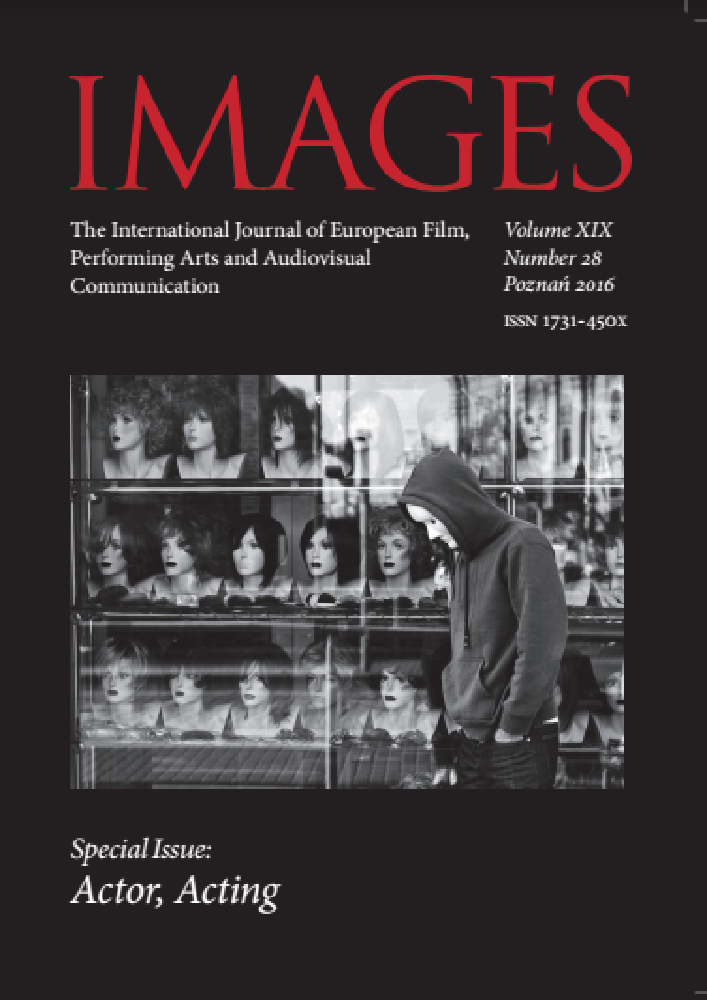Abstract
The General Theory of the Actor and Acting? On the traditional methodology of research in the domain of film acting from the perspective of the theory of performing
These reflections concern film acting, or to be more exact, the canonical three-stage research scenario, i.e. description, analysis and interpretation. They require a methodological interdisciplinary confluence of multiple strands, beyond the confines of a monolithic methodology.
At a certain stage of the methodological reflections on acting (performing) there emerged a tendency to employ various disciplines. I would like to call it “the general theory of the actor and acting” or “the theory of performing”. The theory of performing, in fact, brings together such realms as anthro- pology, semiotics, phenomenology, aesthetics, the theory of literature, the psychology of perception of on-stage and on-screen representations, and, in a narrower sense, also studies on facial expression, diction and prosody, gesture and kinesics. However, in the most rudimentary sense it does consider the fundamental role of the actor and acting to be the focal point of discussion - the question of the very performance.
Does the theory of performing explore the phenomenon of film acting (performing), and if so, to what degree is it the case? Two reference points for this issue seem to emerge.
The first concerns the very choice of the object for analysis, involving such dimensions as relational networks of multiple actions regarding the actor and the process of acting, resulting in the creation of the character in a given film.
The other, directly related to the first, concerns the very point of departure in the exploratory research process. How does the profile of the actor emerge due to such procedures as camera-work, montage, dubbing or motion control? It seems that what should be at the very centre of attention of the general theory of actor and acting is the actor-as-a-real-person, the interpreter of his own role-play, and also the subject of the actions involving the constructive process of a given film role, which results in the final on-stage/on-screen effect. We ought to pose the question of whether or not he is merely an acting element inhabiting the situation of the shooting within the confines of the camera-work. The theory of performing is not so much focused on the actor as an analog of a real human being (the fact that should be considered positively), but is focused on the actual acting process, the process of performing, first and foremost, the autonomous performer. Hence, another question arises: who is the character in the on-screen mode of existence? What is his real identity?
The general theory of the actor and acting strives to answer this question from multiple viewpoints, from the viewpoints of anthropology, structuralism, deconstruction theory, as well as in terms of the most promising approaches (in my opinion), namely the cognitive and phenomenological stances. Here the floor is open for discussion.
References
Brossard P., 1977, Szkic do portretu aktora, przeł. E. Niewczas, „Kino” nr 9.
Cavell S., 2004, Audience, actor, and star, w: Film Acting. Th e Film Reader, ed. P. Robertson Wojcik, London–New York.
Duda A., 2011, Performans na żywo jako medium i obiekt mediatyzacji, Toruń.
Duniec K., 2002, Postać sceniczna jako tekst, w: Aktor teoretyczny, red. J. Krakowska--Narożniak, Warszawa.
Książek-Konicka H., 1980, Semiotyka i film, Wrocław.
Łotman J., 1983, Semiotyka filmu, przeł. J. Faryno, T. Miczka, Warszawa.
Morin E., 1975, Kino i wyobraźnia, tłum. K. Eberhardt, Warszawa.
Mukařovský J., 1970, O dialogu scenicznym, przeł. J. Baluch, w: Wśród znaków i struktur. Wybór szkiców, wybór, redakcja i słowo wstępne J. Sławiński, Warszawa.
Plata T., 2002, Między obecnością a nieobecnością: teatr i aktorstwo po dekonstrukcji, w: Aktor teoretyczny, pod red. J. Krakowskiej-Narożniak, Warszawa.
Saitz R.L., Cervenka E.J., 1972, Handbook of Gestures, 2nd ed., The Hague, London.
Schechner R., 2006, Performatyka. Wstęp, przeł. T. Kulikowski, Wrocław.
Zalewski A.J., 1979, Typy konstrukcji znaczeniowych w filmie. Próba analizy fenomenologicznej, „Kino” nr 5.
License

This work is licensed under a Creative Commons Attribution-NonCommercial-NoDerivatives 4.0 International License.
